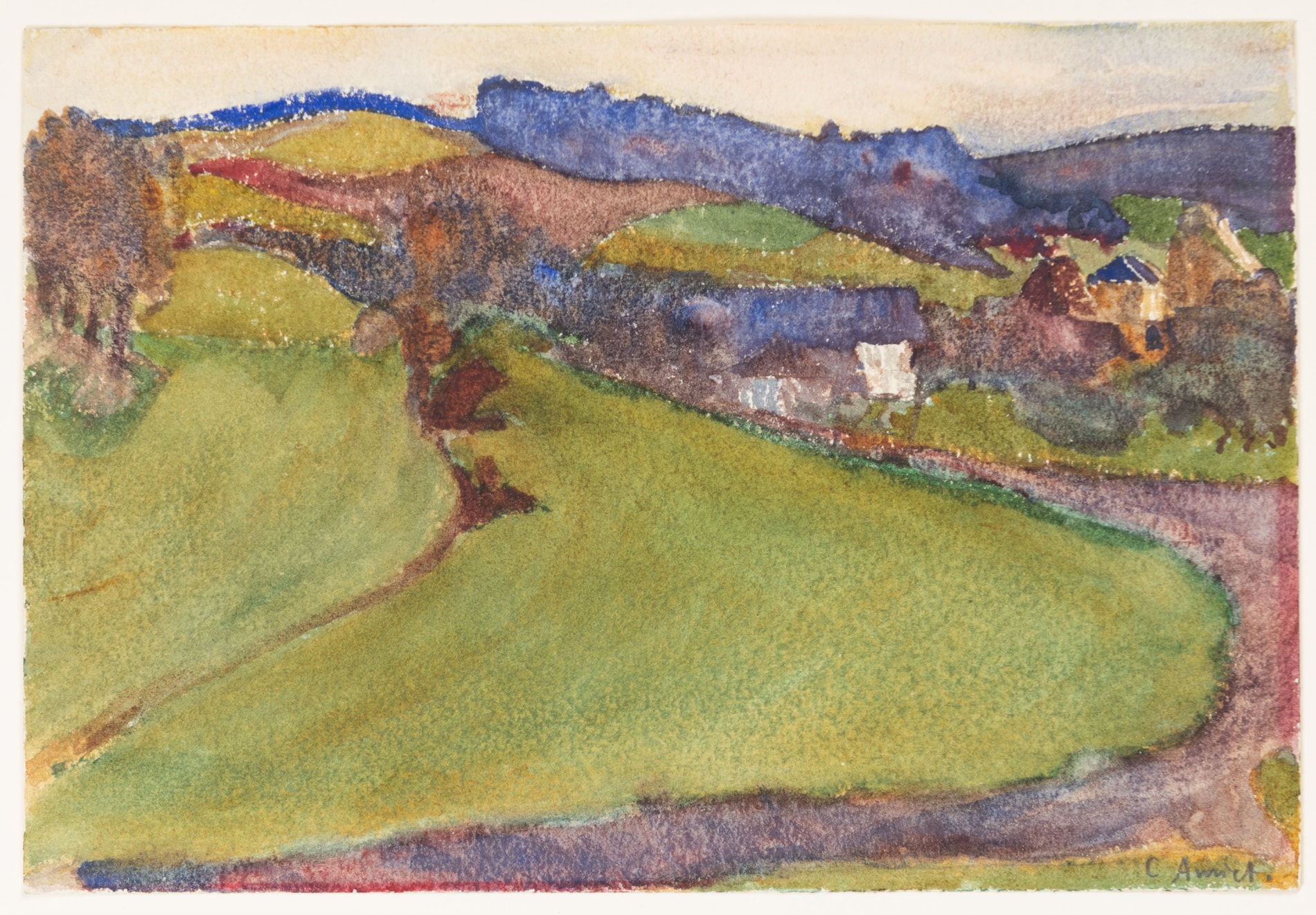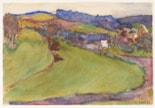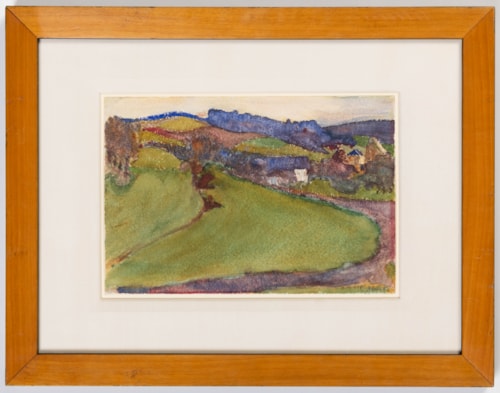Cuno AMIET
(Solothurn 1868 - Oschwand 1961)
Landscape at Hellsau
Sold
Watercolour.
Signed C. Amiet in pencil at the lower right.
183 x 269 mm. (7 1/4 x 10 5/8 in.)
Signed C. Amiet in pencil at the lower right.
183 x 269 mm. (7 1/4 x 10 5/8 in.)
This vibrant early watercolour by Cuno Amiet can likely be dated to the period when the artist was living and working in the small village of Hellsau, in the Swiss canton of Bern. Amiet had begun painting the landscape around Hellsau, a few miles southeast of his native Solothurn, in the late 1880s and early 1890s, and chose to settle there soon after his return from France in 1893, establishing a studio on the upper floor of the Gasthof Freienhof inn. The artist lived in Hellsau until his move to nearby Oschwand in 1898.
Watercolour landscapes by Amiet are relatively rare, and are generally very freely drawn with saturated colours. Among stylistically comparable works are four watercolours - a view of the Bridge at Stampa dated 1891, a view of Maloja dated 1908, a Blue Landscape of c.1910 and a view of the Swiss mountain known as the Schynige Platte of c.1910-1915 – all formerly in the Loeb collection and sold at auction in Switzerland in 2019. Also similar is a view of L’Isle de St.-Pierre, dated 1906, and a Lake Landscape of 1930, both sold at auction in 2020.
The first owner of the present sheet was the German librarian, writer and collector Curt Blass (1881-1972), a close friend of the artist and a passive member of Die Brücke. As a young law student from Leipzig, Blass met Amiet and his wife in Oschwand in 1903 and often spent his holidays with them there in later years. Amiet designed a bookplate for Blass in 1903 and painted three small portraits of him in 1904 and another in 1909. He also produced a number of drawn portrait studies of Blass, together with three portraits in the form of colour woodcuts, executed in 1905, 1906 and 1908. In 1916 Blass married Hanni Miller, a former pupil of Amiet and the daughter of his friend, the Solothurn merchant and collector Oscar Miller.
Watercolour landscapes by Amiet are relatively rare, and are generally very freely drawn with saturated colours. Among stylistically comparable works are four watercolours - a view of the Bridge at Stampa dated 1891, a view of Maloja dated 1908, a Blue Landscape of c.1910 and a view of the Swiss mountain known as the Schynige Platte of c.1910-1915 – all formerly in the Loeb collection and sold at auction in Switzerland in 2019. Also similar is a view of L’Isle de St.-Pierre, dated 1906, and a Lake Landscape of 1930, both sold at auction in 2020.
The first owner of the present sheet was the German librarian, writer and collector Curt Blass (1881-1972), a close friend of the artist and a passive member of Die Brücke. As a young law student from Leipzig, Blass met Amiet and his wife in Oschwand in 1903 and often spent his holidays with them there in later years. Amiet designed a bookplate for Blass in 1903 and painted three small portraits of him in 1904 and another in 1909. He also produced a number of drawn portrait studies of Blass, together with three portraits in the form of colour woodcuts, executed in 1905, 1906 and 1908. In 1916 Blass married Hanni Miller, a former pupil of Amiet and the daughter of his friend, the Solothurn merchant and collector Oscar Miller.
A pioneer of modernism in Switzerland, Cuno Amiet began his training as an artist in 1883, encouraged by the Swiss landscape painter Frank Buscher. Between 1886 and 1888 he studied at the Akademie der Bildenden Künste in Munich, where he met and befriended Giovanni Giacometti (who was to be the father of the sculptor Alberto Giacometti). In October 1888 both artists moved to Paris to study at the Académie Julian, and Amiet’s portrait of Giacometti was accepted at the Salon the following year. In May 1892 he visited the artist’s colony at Pont-Aven, where he lived and worked just over a year. Amiet was strongly influenced by the work of several of the artists of the Pont-Aven school, notably Emile Bernard, Paul Gauguin, Roderic O’Conor, Paul Sérusier and Armand Seguin, who encouraged him to take up printmaking. He exhibited at the Salon des Indépendants in 1893, but the same year had to return to Switzerland for lack of funds. He established a studio in Hellsau, and in 1894 an exhibition of work from his Breton period was mounted at the Kunsthalle in Basel, although it was poorly received by both the public and critics. Three years later Amiet received a commission to paint a frieze intended for the Paris Exposition Universelle of 1900, in collaboration with Giovanni Giacometti, Ferdinand Hodler – who was to become a close friend and a particular influence on the younger artist – and Giovanni Segantini. Although the work was never executed, a painting by Amiet won a silver medal at the Exposition Universelle, and he began to achieve a degree of commercial success as a portrait and landscape painter. In 1898 the newly-married artist settled in the Bernese village of Oschwand in the Upper Aargau, where he lived and worked for the remainder of his career.
Amiet was associated with the Vienna Secession, where he exhibited some thirty paintings in 1904, and in 1906 he became a member of Die Brücke, the German avant-garde group, alongside Ernst Ludwig Kirchner, Max Pechstein and Karl Schmidt-Rotluff. Amiet’s large home and studio in Oschwand, built for him in 1908, became a meeting place for numerous artists and writers, and it was there that he taught his many pupils. It was also where he exhibited and sold his works – landscapes, portraits (including numerous self-portraits) and still life subjects – to collectors, since for the most part Amiet seems to have avoided working with art dealers and galleries. In 1910 he began working on an important public commission, a mural of The Fountain of Youth for the Kunsthaus in Zurich, and in later years earned several further commissions for wall paintings. Following the death of Hodler in 1918 Amiet was established as the foremost painter in Switzerland. A large exhibition of his work was held at the Kunstmuseum in Bern to celebrate the artist’s sixtieth birthday in 1928. Three years later, however, around fifty of his most significant paintings, including many early Breton works, were destroyed in a fire in the Glaspalast in Munich. Having enjoyed a very long career of over seventy years, Amiet died in 1961, at the age of ninety-three. Works by Amiet are today in the collections of several museums in Switzerland, as well as the Van Gogh Museum in Amsterdam, the Brücke Museum in Berlin and the Musée d’Orsay in Paris, among others.
Amiet was associated with the Vienna Secession, where he exhibited some thirty paintings in 1904, and in 1906 he became a member of Die Brücke, the German avant-garde group, alongside Ernst Ludwig Kirchner, Max Pechstein and Karl Schmidt-Rotluff. Amiet’s large home and studio in Oschwand, built for him in 1908, became a meeting place for numerous artists and writers, and it was there that he taught his many pupils. It was also where he exhibited and sold his works – landscapes, portraits (including numerous self-portraits) and still life subjects – to collectors, since for the most part Amiet seems to have avoided working with art dealers and galleries. In 1910 he began working on an important public commission, a mural of The Fountain of Youth for the Kunsthaus in Zurich, and in later years earned several further commissions for wall paintings. Following the death of Hodler in 1918 Amiet was established as the foremost painter in Switzerland. A large exhibition of his work was held at the Kunstmuseum in Bern to celebrate the artist’s sixtieth birthday in 1928. Three years later, however, around fifty of his most significant paintings, including many early Breton works, were destroyed in a fire in the Glaspalast in Munich. Having enjoyed a very long career of over seventy years, Amiet died in 1961, at the age of ninety-three. Works by Amiet are today in the collections of several museums in Switzerland, as well as the Van Gogh Museum in Amsterdam, the Brücke Museum in Berlin and the Musée d’Orsay in Paris, among others.
Provenance
Dr. Curt Blass, Zurich
Thence by descent to a private collection, Switzerland.
Thence by descent to a private collection, Switzerland.





